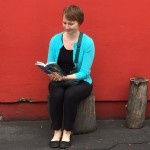The Crooked Path of Inspiration
 Julia McAnallen* speaks three languages, she has degrees in Slavic linguistics and nuclear engineering, and she’s lived in three different countries. From Michigan to Moscow, to Madrid, and back again, her path hasn’t been straight, but it’s been inspired.
Julia McAnallen* speaks three languages, she has degrees in Slavic linguistics and nuclear engineering, and she’s lived in three different countries. From Michigan to Moscow, to Madrid, and back again, her path hasn’t been straight, but it’s been inspired.
Today, Julia is in a job that seems custom-made for her. What have been her lessons along the way?
- Find Your Own Inspiration – Julia pursued a STEM (science, technology, engineering, mathematics) education with her teachers’ encouragement. It was during the early 90s when talented women were being guided into those fields. Julia finished her Engineering degree but it never felt like a fit. She toyed with law as a next-career-option. She even worked for the Nuclear Regulatory Commission of the federal government, but quickly realized it wasn’t for her. She wanted something different. She wanted to follow her inspiration and her passion so she made a huge change and went into Russian linguistics.
- Just Go – When Julia decided to break with her previous path, she moved to Moscow. What better place to study Slavic languages and immerse into the Russian culture? And what better experience on her way to completing her doctoral degree from UC Berkeley? It was a risk, but the total break from her previous world allowed her to learn in brand new ways and places.
- Compartmentalize – Julia values separation between her work and everything else in her life. While she was in grad school, everything she did was related to the work of her learning. “Every minute, I was either doing work or thinking about the work I should be doing,” she says. She loves the job she has now, but she enjoys breaks from work. She takes vacation (most recently to Peru and to Mexico City) and turns off. She runs (a half marathon and a marathon last year). She leaves her work at work at the end of the day. All of these allow her to compartmentalize, and she knows this ability to separate and distance herself from her work is important to her engagement and effectiveness when she is working.
- Connect – When Julia was in Madrid she was struck by how often co-workers socialized and went out together after work. They would walk around. They would go for drinks. They would have coffee. Unlike in the US where we frequently go home from work and stay home, they were together, they were out, and they were connecting. Julia appreciates the importance of these opportunities to be in community with others.
What advice would she give to others about work-life? She says you should ask yourself, “How do I want my life to look?” Figure out what inspires you, figure out your priorities, and build from there. Don’t be afraid to change course in order to navigate to your right destination.
 *Dr. Julia McAnallen is a Career Specialist in the PhD career services office at Michigan State University.
*Dr. Julia McAnallen is a Career Specialist in the PhD career services office at Michigan State University.
Would you like to tell your story? If so, let me know by emailing me at tbrower108@gmail.com. Why? One of the foundations of Bringing Work to Life is abundance: the idea that it is possible to find fulfillment, have it all, and avoid the trade-offs between work and life. After all, work and life aren’t separate things to be placed in containers, but part of an integrated whole of a satisfying life. Another foundation of Bringing Work to Life is the idea of multiple right answers. As we’re all seeking ways to bring work to life – and bring life to work – we can learn from each other’s unique solutions and stories. I’d love to learn about your story!
Tracy Brower is the author of Bring Work to Life by Bringing Life to Work: A Guide for Leaders and Organizations.